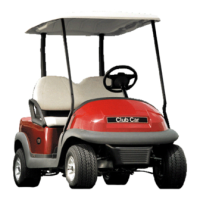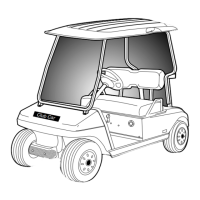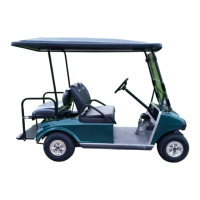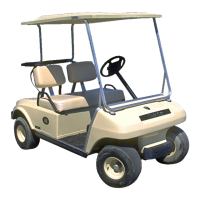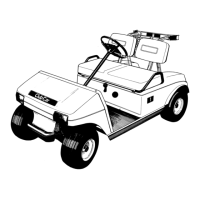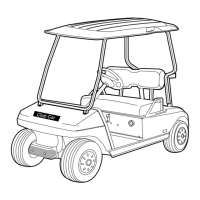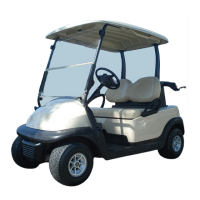
Do you have a question about the Club Car 2006 Precedent and is the answer not in the manual?
| Brand | Club Car |
|---|---|
| Model | 2006 Precedent |
| Category | Offroad Vehicle |
| Language | English |
Details the Club Car Limited Lifetime Warranty for Precedent golf cars.
States Club Car is not liable for errors in the manual or resulting damages.
Confirms vehicle conformance to ANSI Z130.1 Safety and Performance Requirements.
Thanks the customer for choosing Club Car and highlights vehicle value.
Urges readers to follow operating instructions and safety precautions.
Provides contact information for authorized Club Car representatives.
Recommends keeping the owner's manual with the vehicle for future owners.
Warns that the vehicle exceeds ANSI Z130.1 speeds and advises caution.
Details operation steps: key switch, F/R switch, pedals, and stopping.
Describes the two-position ON/OFF key switch for vehicle operation.
Identifies and describes the function of the brake and accelerator pedals.
Provides critical safety warnings regarding vehicle operation and occupancy.
Warns about the weight of batteries and the need for a lifting tool.
Cautions that water exposure may damage electronic components.
Identifies the location of the battery charger receptacle.
Identifies the location of the forward/reverse selector switch.
Warns about battery explosion and component damage related to the switch.
Warns of personal injury or death from shorting battery terminals.
Identifies the low oil warning light on the dash panel.
Details operation steps: key switch, F/R handle, pedals, and stopping.
Describes the two-position ON/OFF key switch for vehicle operation.
Identifies and describes the function of the brake and accelerator pedals.
Provides critical safety warnings regarding vehicle operation and occupancy.
Warns about battery explosion/fire risk due to frame contact.
Warns about hazards from rotating parts and hot exhaust components.
Identifies the location of the forward/reverse selector handle.
Identifies the location of the choke control for starting.
Warns about gasoline hazards and tampering with the governor.
Explains the severity of injury from rotating parts.
Emphasizes understanding DANGER, WARNING, and CAUTION statements.
States product contains chemicals known to cause cancer or birth defects.
Stresses reading the manual and ensuring safety decals are in place.
Defines DANGER, WARNING, and CAUTION symbols and their meanings.
Warns about explosive gases from batteries and necessary precautions.
Highlights hazards of gasoline: flammability, carbon monoxide.
Provides guidance for seeking shelter during storms.
Covers unattended children, parking brake, key removal, and modifications.
Advises on safety gear, tools, and qualified technicians for servicing.
Details the Tow/Run switch function and battery disconnection.
Provides step-by-step instructions for safe battery disconnection.
Introduces electric and gasoline models and the IQ System.
Explains where to find the vehicle's serial number for inquiries.
Recommends establishing a safety committee for golf car operation.
Describes the function and positions of the key switch.
Explains operation of the F/R rocker switch and reverse buzzer.
Identifies the dash-mounted battery warning light.
Details the accelerator pedal's function and motor braking features.
Explains the feature preventing uncontrolled rolling on slopes.
Describes Pedal Down and Pedal Up motor braking for speed control.
Explains the meaning of the battery warning light illumination.
Details the Tow/Run switch operation and its effect on motor braking.
Specifies conditions for placing the Tow/Run switch in TOW.
Provides essential safety warnings for operating the vehicle.
Describes the two-position ON/OFF key switch for vehicle operation.
Explains operation of the F/R handle and reverse buzzer.
Details the accelerator pedal's function for starting and speed.
Describes the function of the brake pedal for slowing and stopping.
Explains how to set and release the park brake.
Describes the lockout mechanism for maintenance and operation.
Details the use of the choke for starting in cold conditions.
Explains the neutral lockout cam's function in maintenance mode.
Explains the neutral lockout cam's function in normal operation.
Details the use of the choke for starting in cold conditions.
Explains the function of the low oil warning light and required action.
Covers checks for nuts, bolts, screws, decals, and tires.
Details how to check tire pressure, wear, and damage.
Checks for batteries, charger cord, plug, and receptacle.
Checks battery, engine oil, fuel, and exhaust system.
Warns to remove seat plastic before operation to prevent fire.
Covers F/R switch, brakes, park brake, reverse buzzer, and steering.
Verifies smooth acceleration and pedal return on electric models.
Explains Zero Speed Detect and motor braking for electric models.
Covers accelerator operation and governor speed limits.
Provides rules for licensed drivers, passenger limits, and vehicle equipment.
Advises on body position, slopes, turns, terrain, and avoiding sudden actions.
Prohibits use on public roads and driving under influence of substances.
Step-by-step guide for starting the vehicle safely.
Explains downhill speed control for electric and gasoline vehicles.
Details the procedure for stopping the vehicle using the brake pedal.
Covers securing the vehicle with the park brake and key.
Crucial safety points for towing vehicles, including speed and bar usage.
Guidelines for securely transporting vehicles on trailers.
Instructions for gasoline vehicles regarding fuel shut-off valve.
Steps for preparing electric vehicles for storage.
Warns that batteries in low charge can freeze.
Advises against pressure washing to protect electrical components.
Details steps like charging batteries and cleaning the vehicle.
Instructions for bringing stored electric vehicles back into use.
Safety notes for storing gasoline vehicles, including key and fuel valve.
Highlights dangers associated with fueling gasoline vehicles.
Steps for preparing gasoline vehicles for long-term storage.
Illustrates the closed position of the fuel shut-off valve.
Steps to restore fuel systems and reconnect batteries.
Shows partially closed and open positions of the fuel shut-off valve.
Stresses the importance of a preventive maintenance program.
Warns against operating a vehicle with unrepaired problems.
Specifies that only trained technicians should perform service.
Safety steps for servicing electric vehicles, like battery disconnect.
Safety steps for servicing gasoline vehicles, like fuel valve and frame ground.
Emphasizes adherence to the maintenance and service manual.
Lists daily, weekly, monthly, semiannual, and annual service tasks.
Lists monthly, semiannual, annual, and two-year service tasks.
Warns that service issues require repair before operation.
Details lubrication points and recommended lubricants for electric vehicles.
Details lubrication points and lubricants for gasoline vehicles.
Recommends authorized dealers for controller repair and service.
Details dangers of explosive gases and battery acid.
Advises on safety gear like glasses, face shields, and gloves.
Recommends turning off accessories before charging batteries.
Notes proper recycling or disposal of batteries.
Explains new battery conditioning and initial charge requirements.
Details cleaning battery tops and terminals with baking soda solution.
Guides on checking and adding distilled water to maintain electrolyte levels.
Specifies tightening torque for hold-downs and terminals.
Warns about overheating and fire risk from damaged terminals.
Emphasizes ventilation to prevent hydrogen gas accumulation and explosion.
Recommends only trained technicians should repair or service the charger.
Specifies dedicated 15 or 20 ampere protected branch circuits.
Covers warnings about extension cords, damage, liquids, and ventilation.
Warns against connecting damaged chargers or receptacles.
Advises on DC cord removal, ventilation slots, and material covering.
Details daily inspection of charger cord, plug, and receptacle.
Provides instructions for correctly connecting the charger plug.
States that only PowerDrive chargers are compatible with Precedent vehicles.
Explains the automatic charging cycle and OBC interaction.
Advises on charging batteries in unheated areas during cold weather.
Describes how the charger turns on and the vehicle lockout.
Recommends cleaning plug/receptacle contacts for good connection.
Warns about explosive gases and battery acid hazards.
Prohibits jump starting a dead battery with another battery and cables.
Details cleaning terminals and applying protector spray.
Warns of overheating and fire risk from corroded terminals.
Instructs on monthly checking of engine oil level using the dipstick.
Notes proper recycling or disposal of used engine oil.
Covers key off, engine cool, and fuel tank grounding before fueling.
Advises not to overfill the fuel tank to allow for expansion.
Guides on how to fill the fuel tank with fresh unleaded gasoline.
Warns about static electricity during fueling and grounding requirements.
Advises against oxygenated fuels and fuels blended with alcohol.
Recommends hand washing with automotive cleaners; no pressure washing.
Warns against using compounds that dull finish and waxing specific surfaces.
Notes accessory availability and advises professional installation.
Urges new owners to register their vehicle with Club Car.
Introduces the Villager 4 and recommends reading the manual.
Provides safety advice for passengers in the Villager 4 model.
Directs users to periodic service and lubrication schedules.
Details requirements for the onboard charger's AC power connection.
Warns about dedicated branch circuits for the charger.
Advises turning off accessories and unplugging before driving.
Highlights safety warnings for passengers regarding falling off.
Details specifications for motor, transaxle, electrical system, and engine.
Lists specifications for steering, suspension, and brake systems.
Provides details on frame, body material, finish, and tires.
Lists overall length, width, height, wheelbase, and weight.
Specifies the rear wheel tread measurement.
Lists the weight of electric and gasoline vehicles.
Indicates the maximum forward speed in mph and km/h.
Specifies the diameter of the curb clearance circle.
States the standard seating capacity for vehicle models.
Lists capacities for transaxle, engine crankcase, and fuel tank.
Specifies recommended tire pressure in psi and bars.
Outlines warranty periods for various vehicle components.
Lists conditions and causes that void the warranty.
Details actions that will void the warranty, like abuse or modification.
States that repair or replacement is the sole remedy for defects.
Clarifies that this is the exclusive warranty and disclaims implied warranties.
Excludes liability for incidental or consequential damages.
Provides contact details for warranty services.
Explains the process for transferring remaining warranty coverage.
Warns that modifications can cause personal injury or death.
Explains owner's rights and obligations regarding emission control warranty.
States the emission control system is warranted for two years.
Details owner's duties like performing maintenance and reporting issues.
Explains the coverage for emission-related parts.
Lists specific emission control system parts covered under warranty.
Lists causes for exclusion from emission warranty coverage.
Details actions that will void the emission warranty.
Excludes liability for consequential damages related to emissions.
Provides instructions on how to file an emission warranty claim.
Specifies using unleaded regular grade gasoline with 87 octane.
Describes the sealed crankcase system for blow-by gases.
Explains the carburetor and ignition system for emission control.
Stresses that proper maintenance ensures compliance with standards.
Lists prohibited acts that constitute tampering with emission controls.
Recommends clean, fresh, unleaded gasoline and API SC-SH engine oils.
Provides guidelines for using fuels with ethanol, MTBE, or methanol.
Warns about gasoline's flammability and explosion risks.
Specifies the API service classification for recommended engine oils.
Shows recommended oil viscosity based on ambient temperature.
Notes that multi-grade oils may increase oil consumption.
